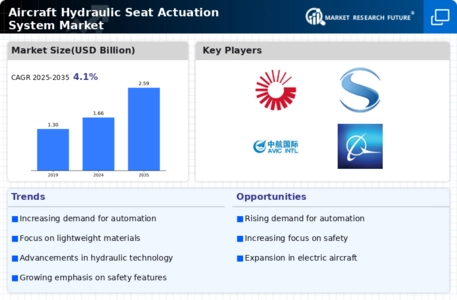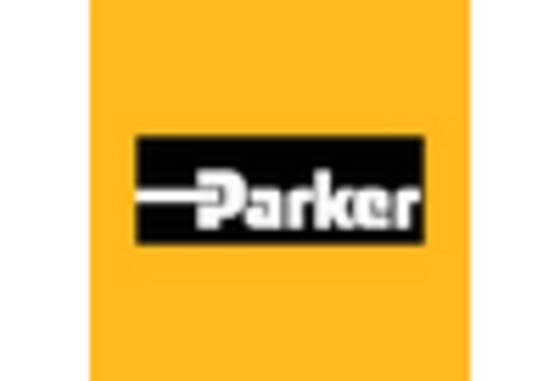Emphasis on Enhanced Passenger Experience
The Aircraft Hydraulic Seat Actuation System Market is significantly influenced by the growing emphasis on enhancing passenger experience. Airlines are increasingly recognizing the importance of comfort and convenience in attracting and retaining customers. Hydraulic seat actuation systems play a crucial role in providing adjustable seating configurations that cater to diverse passenger needs. Recent surveys indicate that over 70 percent of travelers prioritize comfort when selecting airlines, underscoring the necessity for advanced seating solutions. As a result, manufacturers are likely to focus on developing innovative hydraulic systems that not only improve comfort but also integrate seamlessly with in-flight entertainment and other amenities, thereby driving market growth.
Increasing Demand for Lightweight Materials
The Aircraft Hydraulic Seat Actuation System Market is experiencing a notable shift towards the adoption of lightweight materials. This trend is driven by the aviation sector's ongoing efforts to enhance fuel efficiency and reduce operational costs. Manufacturers are increasingly utilizing advanced composites and lightweight alloys in seat actuation systems, which not only improve performance but also contribute to overall aircraft weight reduction. According to industry estimates, the use of lightweight materials can lead to a reduction in fuel consumption by up to 15 percent. As airlines seek to optimize their fleets, the demand for innovative hydraulic seat actuation systems that incorporate these materials is likely to rise, thereby propelling market growth.
Regulatory Standards and Safety Enhancements
The Aircraft Hydraulic Seat Actuation System Market is also shaped by stringent regulatory standards and safety enhancements. Regulatory bodies are continuously updating safety requirements for aircraft seating systems, necessitating the adoption of advanced hydraulic actuation technologies. Compliance with these regulations is essential for manufacturers to ensure the safety and reliability of their products. Recent updates in aviation safety regulations have emphasized the need for robust seat actuation systems that can withstand various stressors during flight. This focus on safety is likely to drive innovation within the Aircraft Hydraulic Seat Actuation System Market, as companies strive to meet and exceed regulatory expectations while enhancing the overall safety of aircraft seating.
Rising Focus on Automation and Smart Technologies
The Aircraft Hydraulic Seat Actuation System Market is witnessing a surge in the integration of automation and smart technologies. As airlines and manufacturers strive to enhance operational efficiency and passenger experience, the incorporation of automated seat actuation systems is becoming increasingly prevalent. These systems offer features such as programmable seating positions and real-time adjustments, which cater to individual passenger preferences. The market for smart technologies in aviation is projected to grow significantly, with estimates suggesting a compound annual growth rate of over 10 percent in the coming years. This trend indicates a strong potential for the Aircraft Hydraulic Seat Actuation System Market to evolve in tandem with advancements in automation.
Expansion of Aircraft Fleet and New Aircraft Programs
The Aircraft Hydraulic Seat Actuation System Market is poised for growth due to the expansion of aircraft fleets and the introduction of new aircraft programs. As airlines continue to invest in modernizing their fleets, the demand for advanced hydraulic seat actuation systems is expected to increase. Recent data indicates that the global commercial aircraft fleet is projected to grow by approximately 4 percent annually over the next decade. This expansion is likely to drive the need for innovative seating solutions that enhance passenger comfort and safety. Consequently, manufacturers in the Aircraft Hydraulic Seat Actuation System Market are likely to benefit from this upward trend as they develop systems that meet the evolving needs of airlines.

















Leave a Comment